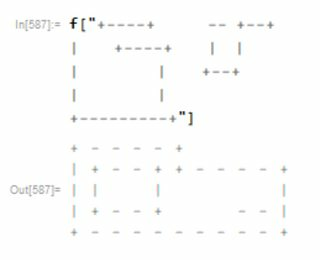7
4
Challenge
Make the shortest program to determine if the figures in the input will fit into the space in the input.
Requirements
The input will be in the format of this example: Input:
+----+ -- +--+
| +----+ | |
| | +--+
| |
+---------+
Output:
+----+
|+--++----+
|| |-- |
|+--+ |
+---------+
First, starting in the upper left corner, is the space that the program will try to fit the figures into. Then there is a space. Then there is a figure, in this case two dashes. Then there is a space, then a second figure. The output is the figures fitted inside of the space.
Rules about figures and input:
- The upper left corner of a shape will always be on the first row.
- After a figure, there is one space, as shown in the example.
- There is no limit on the size of the figures.
- The first figure will always be the space that the program will determine if the figures fit into.
- There is no limit on the number of figures, but there will only be one space to fit them into.
- All figures will be made of
|and-for the sides and+for the corners. These are the only characters used besides spaces and newlines. - Figures cannot be rotated.
- Borders cannot overlap.
- You may fit one figure inside of another.
- The figures do not have to be closed.
- The space will always be closed.
- The space does not have to be completely filled.
- You may not split up shapes.
Rules about output:
- If the figures fit into the space, the program should output the figures inside of the space, as shown above. It does not matter how they are arranged, as long as no borders overlap, all figures are correct, and no shapes are split up.
- If the figures do not fit, output "no".
Examples
Input:
+--+ |
+--+
Output:
no
Input:
+---+ -+
| | |
| |
+---+
Output:
+---+
|-+ |
| | |
+---+
This is also valid:
+---+
| -+|
| ||
+---+
Input:
+----------+ +-----+ -+
| | | | |
| | | |
| | +-----+
| |
+----------+
Output:
+----------+
|+-----+ |
||-+ | |
|| | | |
|+-----+ |
+----------+
This is a code golf, so the shortest answer wins.

2You say make the shortest program at the top, but answer with most votes wins at the bottom. Note that this will get closed as a popularity contest. – Dennis – 2017-02-22T14:53:06.833
1This isn't a programming puzzle either. That has a fairly specific meaning; check the tag wiki for more information. – None – 2017-02-22T14:54:23.303
I fixed this. It is now a code golf challenge – Dave Jones – 2017-02-22T14:56:55.717
1Consider editing out the specific "no" output, and either (1) only having to handle valid input (any behaviour); or (2) allowing standard falsey outputs and errors. – Jonathan Allan – 2017-02-22T15:07:38.710
It looks like the two
--are misplaced in one of the first two images [Requirements]. – Jonathan Allan – 2017-02-22T15:09:43.873Which is the upper-left corner in ambiguous cases? – Jonathan Allan – 2017-02-22T15:10:48.897
"The first figure will always be the space that the program will determine if the figures fit into." - can we not take the two figures separately? Parsing out the set of figures seems to detract from the main task. – Jonathan Allan – 2017-02-22T15:12:34.853
If the case is ambiguous, the first character in the input will be the upper corner of the space. The program does not have to output anything if the input is invalid. It outputs "no" is the figures do not fit into the space. – Dave Jones – 2017-02-22T15:18:26.490